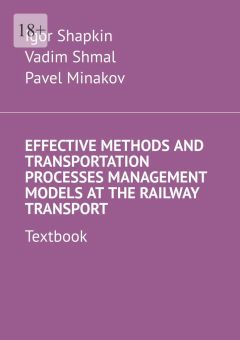Текст книги "Effective Methods and Transportation Processes Management Models at the Railway Transport. Textbook"

Автор книги: Igor Shapkin
Жанр: Прочая образовательная литература, Наука и Образование
Возрастные ограничения: +18
сообщить о неприемлемом содержимом
Текущая страница: 6 (всего у книги 11 страниц)
4.2 Markov chains in the dynamics of objectively developing events in the human-machine system, which is still the transportation process
Optimization using dynamic probabilistic models generated by Markov processes is called Markov programming. The analysis of linear Markov models in solving conditional extremal problems is reduced to solving linear programming problems.
Interest in solving optimization, at least linear, problems with randomly variable parameters has recently increased dramatically due to the needs of practice that is not satisfied with the simplest models, and the availability of modern effective methods for solving problems.
Consider a class of problems that, with some reservations, can be considered stochastic. We are talking about optimizing the function of the goal given using a statistical model, which allows, in principle, to calculate the values of any functionals from the parameters of the system included in the model.
A method for optimizing the functionality is proposed, specially adapted for the case of setting it using a statistical model.
Let’s consider a model for calculating the parameters of a passenger technical station as a multiphase queuing network with probabilistic characteristics.
Taking into account random components in the time of operations and the incoming train traffic leads to probabilistic models of the passenger technical station (PTS), considered as a multiphase queuing system (MQS) with random durations of work on individual operations, including the duration of the train’s stay in the departure park /DP/. Such randomization simplifies the procedure for calculating the time spent by cars on the PTS and, assuming exponential distributions of the durations of operations in the service phases and the Poisson input flow, makes it possible to write out analytical dependencies for the main characteristics of operation. At the same time, the question remains open, what error does such an approach to modeling the operation of the PTS give, if the parameters of the distribution laws, with the help of which it is possible to approximate the empirical laws of distributions of the times of operations and input intervals, are not exponential. The answer to this question can be given by statistical modeling of the PTS as a service network. Therefore, let’s consider the algorithms of the statistical model of the PTS in the same formulation as in the analytical model, but with arbitrary distributions of random variables.
4.3 Algorithm for optimizing a passenger technical station using probabilistic models as a complex system
To solve various problems of optimal design that arise during the optimization of complex systems, a number of algorithms have been developed that take into account the peculiarities of each specific case.
Due to the fact that the solution of the problem of optimal design of the PTS is carried out using a statistical model, the optimization algorithm must take into account the fact that the objective functional calculated from the simulation results will be obtained with some unpredictable error in advance.
There are algorithms that are focused on solving problems of this class. For example, a number of algorithms for solving problems of optimization of queuing systems are described provided that the generalized efficiency indicator is calculated based on the simulation results.
The algorithm assumes that the variable parameters are continuous. The essence of the described algorithms is the use of the theorem on the equality of sample means, calculated from two different samples.
In fact, if with 2 runs of the statistical model under changed initial conditions (for example, the number of devices performing technological operations is changed, the scheme for performing technological operations is changed), different values of the characteristics of the system – performance indicators – are obtained.
Then, based on these characteristics, generalized indicators are calculated.
If a change in any parameter lies in the dead zone of the output parameter, then it is natural to expect that the change in the input parameter will not have a significant impact on the change in the output parameter, in particular, on the generalized indicator of the PTS.
As long as this is the case, and as long as the generalized exponent is calculated as a function of the sample means, which, in turn, are random variables with normal distributions, the value of the objective functional obtained from the simulation results can be considered as a sample mean calculated from a sample of a finite volume from a certain population.
In this case, the general population must be understood as the entire set of values of the objective functional that can be obtained with various sequences of pseudorandom numbers that simulate the input train flow and the duration of technological operations.
If the change in the input parameter does not significantly affect the output parameter, then the value of the target functional for two different sets of PTS parameters will be values belonging to the same population.
This leads to the conclusion that in order to estimate in the statistical sense the difference between the two values of the objective function, it is necessary to apply the methods of mathematical statistics to estimate different sample means, i.e. methods for testing the hypothesis that different sample means belong to the same population.
The development of the ideas set forth in the works was first implemented in the work, in which an algorithm was developed designed to solve the problem of optimizing the precinct station. This algorithm is a combination of the method of coordinate descent by 6 methods of mathematical statistics, focused on testing the hypothesis by belonging to 3 sample means of the same population.
However, this method is not quite acceptable for solving the problem of optimization of the PTS. This is explained by the fact that the number of variable parameters in the optimization of the PTS is much greater than the number of parameters varied in the optimization of precinct stations.
With a significant increase in the number of variable parameters, the number of runs of the statistical model will increase, which will make unacceptable the total time of the computer to find the global extremum.
In addition, when applying the method of coordinate descent, the question of the convergence of the search procedure to the global extremum remains open.
Based on the foregoing and based on the classical methods for solving nonlinear programming problems set forth in the above-mentioned works, it was concluded that in order to solve the problem of optimal design of the PTS, an algorithm is needed that combines the advantages of the random search method developed by Academician L.A. Rastrigin and the methods of mathematical statistics to test the hypothesis of belonging to 2 different samples of the same general population.
4.4 Selection of the effective and legitimate expert assessments scope in the considered discrete-continuous movements of the train and commodity flows in time and space
In practice, when solving transport problems, every now and then there is a need to reconcile different points of view, to obtain a solution that satisfies various, sometimes contradictory requirements – criteria. For example, when organizing the work of transport facilities in a market economy, management seeks to maximize the amount of work, increase profits as much as possible, and make total costs as low as possible.
When designing a transport system, the requirements of its greatest efficiency at the lowest cost are natural. In the study of this kind of so-called multi-criteria tasks, it is necessary to reconcile various requirements, to look for a reasonable compromise. Naturally, mathematics has some methods adapted to find compromise solutions in multicriteria problems. However, these methods are far from perfect. In his article «Methodological Features of Applied Mathematics at the Present Stage of Its Development», Professor E.S. Ventzel writes: «So far, practically the only instance capable of quickly and successfully working out a compromise solution is the human mind, the so-called «common sense». Man is still an unsurpassed master of compromise, and without his participation, a solution in a multi-criteria problem (not optimal, perhaps, according to any criterion, but acceptable in their totality) cannot yet be chosen.
Mathematics in its modern form can operate only with the concepts of «more», «less», «equal», but not with concepts such as «acceptable», «practically equivalent», etc., characteristic of human thinking. Apparently, not every «better or worse» can be reduced to «more or less» (or, if it can, we often don’t know how to do it). When making a decision, a person, without going into unnecessary details, looks around the situation as a whole and chooses an acceptable option. As for mathematics, its business in such cases is not to give a final solution, but to help a person choose it. Give the decision-maker the maximum of the information he needs in an expressive, digestible form; to show what consequences each of the possible solutions will lead to (according to a number of criteria), having previously discarded all non-competitive ones.
Mathematics is the basis of formal methods of studying the situation. Common sense, accumulated experience is the basis of formal methods that operate with informal, say, with numerical data, and with qualitative characteristics such as «more beautiful», «simpler», «more comfortable», etc.
It is with such characteristics that one often has to deal with in various situations in the transportation process. When analyzing performance indicators, it is sometimes not possible to obtain analytical dependencies of changes in their components on most of the factors that actually affect them. Moreover, it is not always even possible to definitely indicate all the active causes that determine the indicator or process under study. For example, when there is a surplus fleet of locomotives on the road in some areas, it is quite difficult to establish the causes. At the same time, it is obvious that only after determining all the main causes can it be possible to predict the further development of the process and develop a set of adjustment measures to stabilize the process and eliminate losses in operational work.
Usually, the decision-maker in such cases, with limited statistical material, identifying the underlying causes, uses intuition and accumulated experience. The best result is given by expert assessments.
Mankind has long known for centuries a proven method of combining formal and non-formal principles in a single procedure. This method is expertise. Expert assessments provide a natural opportunity to use the accumulated universal human experience, the social memory of mankind in large (management of social, economic processes) and small, sectoral, tasks.
With repeated repetition of examinations, there is a side (in relation to the development of an agreed solution) opportunity to assess the merits of the experts themselves. It is possible to ascribe a certain «weight» to the expert, just as it is done in the development of an objective assessment. An expert can, for example, be assigned a «weight» the greater, the less (on average) his conclusion deviates from the collective average. Thus, in the process of examination, it is possible to introduce an element of «feedback» that contributes to the self-training of experts, a kind of «tuning» of the entire expert commission to conclusions on a certain range of issues.
The degree of consistency of expert opinions can be assessed on the basis of different principles. In some cases, the standard deviation (variance) of the numerical estimates of experts from the average estimate is taken as a measure of consistency. The smaller the variance, the more consistent the opinions of experts; The larger it is, the greater the range of opinions and the expertise is less qualitative.
The procedure for working with experts is well developed and regulated by a number of provisions, the simplest of which are as follows:
1. Only recognized experts in the relevant field may be experts;
2. Since each expert can make mistakes, only the opinions of a sufficiently large number of experts can satisfactorily characterize the issue under study.
3. The questions posed to experts should be relatively simple and posed so clearly as to exclude the possibility of ambiguous interpretation.
Permanent groups of organizers should be created to guide the examinations, because only a well-thought-out system of questions (for the development of which qualified specialists are needed) can be successful in a relatively complex examination.
The ideological basis of the method of expert assessments is the hypothesis: a collective opinion is preferable to an individual one. And although in most cases this is true, history knows situations in which this hypothesis turned out to be erroneous.
In some cases, it is possible that only one expert can give an assessment that fully reflects the actual state of affairs. For example, it is not difficult to assess the situation at the station that arises in case of violation of the normal removal of trains. But, as a rule, the results of operational activities depend on a large number of reasons. Their correct assessment is possible only with the participation of several experts. It is also necessary to mathematically correctly process the results of expert assessments. For example, when analyzing the work of roads, departments, expert assessments should be given by a sufficiently representative circle of employees of the surveyed enterprise in order to have reliable results. This is done as follows. Each expert is given an expert sheet with a list of assessments of their influence. Thus, expert assessments are the collective opinion of specialists, which is resorted to, as a rule, in the analysis of complex processes, the behavior of which depends on a large number of interrelated causes.
Expert assessments can also be a stage of analysis that allows you to more clearly formulate a priori information about the process under study and mark the most significant reasons.
One of the most well-known and apparently the most ancient principles of choosing the resulting ratio is the majority principle.
This principle is as follows. Let be given N rankings of m objects: r1… rN. In this case, the object that most experts put in the first-place falls on the first place in the resulting ranking; on the second – the object that most experts put on the second, etc.
Consider one of the methods proposed by the French mathematician Jean Antoine Condorcet (1743—1794).
Condorcet’s principle of finding the" majority will" is to reduce each opinion to its simplest components.
If we ask each voter to rank the candidates (or alternatives) in order of their preference, the result is all the elements necessary for a complete analysis. Ranking is a procedure for ordering objects performed by experts.
Without changing the generality of reasoning, for clarity, we will make a specific example. Let three alternatives be given and six experts put their judgments in order of preference. As a result, we get a matrix of rankings.
5 MODERN METHODS AND MODELS OF MULTIFACTOR RATIONING AND FORECASTING IN RAILWAY TRANSPORT
The need for operational forecasting of train work is primarily associated with unevenness. The unevenness in train work is due to the irregularity of loading, unloading and transferring cars at the joints. Deviations from the average values reach ten percent for the seasons of the year, months, days and hours of the day. At the same time, the number of freight trains, their location and pass on single-track lines exactly coincide with the train schedule in no more than 6% of cases, and on double-track lines – in 2% (for the annual period). Fluctuations in train and car traffic significantly complicate the organization of operational work. Therefore, in freight traffic, a reliable detailed forecast is the basis for success in managing the transportation process, in particular train work.
One of the indicators characterizing the quality of operational management is the size of the unadjusted planning period. At stations in the link «station dispatcher – performers» it is 1—2 hours, and in the links «train (nodal) – station dispatcher» – 2—4 hours, etc. The difficulty of finding the right solution in the organization of train work increases with an increase in the planning period. At present, the unadjusted planning period for the departure of trains from the station is 3 hours for the next 2—3 hours, train formation at each marshalling yard is viewed quite accurately. But then, for each subsequent hour, the «visibility» of the situation decreases rapidly.
In the 60s, the Perm branch of the Sverdlovsk railway managed to increase the uncorrected train departure plan to 6 hours. It is no accident that Sverdlovsk railway workers, who were among the first to appreciate the advantages of reliable forecasting and planning of train work, initiated the connection of computers to these processes.
In the 70s, the South Ural Road achieved significant success. On the second-generation Ural-14 computer, daily planning was established here, and then forecasting the approach of trains and train formation at the marshalling yards of the main course, i.e. elements of the «Road Dispatcher» system were introduced. The estimated 24-hour period was divided into 8 three-hour intervals. In each interval, the computer determined the forecast of the number of arriving and departing trains, which the program then «tied» to the threads of the schedule. In those years, only up to 12 influencing factors could be taken into account. Nevertheless, the indicators of the daily plan and the «Road Dispatcher» calculated by the machine were quite reliable and were used in practice.
Modern computers and computer networks have incomparably greater opportunities. They make it possible to implement more accurate, information-provided calculation models. And this is obviously the best reliability, greater detail of indicators, calculation of not only the volume of train work, but also possible difficulties both for the billing period as a whole and for each interval. And, what is still very important, the reliable billing period increases to 36 hours. This is especially important for the organization of the work of locomotive crews and locomotives on the extended section of circulation.
The range of users in the system is very wide – from the station dispatcher to the managers and RTMC dispatchers. Moreover, each user should be given the opportunity to order and receive an individual machine output of the results in the form of a printed table or from the display screen. The forecast is given for three groups of indicators for each dedicated marshalling yard or butt station: the arrival of trains from the direction of interest (total, dismantling, transit); train formation, i.e. readiness for the departure of trains of its formation, transit (it is possible for the direction as a whole and for each destination); readiness of locomotives (each series and depot of registration) for the export of trains in one direction or another.
The number of intervals and their duration for each predicted indicator is set by each user. For example, the RTMC dispatcher for his shift needs to calculate indicators for 3-hour intervals, and for subsequent 12-hour shifts – for each duty as a whole.
Thus, the «Regional Dispatcher» system allows you to expand the depth and reliability of proactive dispatch control (36 hours ahead). At this information and predictive stage of operation, adjustment measures are chosen by the dispatcher or other «decision maker».
In the process of pre-project survey, the number and content of the issuance forms are established, and surveys of users of the system are conducted.
For example, the issuance of a forecast for the arrival of trains (including dismantling and transit) from all directions is necessary for the management and management of train work to the deputy head of the road, the heads of the transportation service, the operational and administrative department, and the chief road dispatcher.
In obtaining a forecast of the arrival of trains at a dedicated station (from an even or odd direction), the dispatching apparatus of the RTMC, DCC, OC needs. We also need a forecast of the arrival of transit trains from all directions.
For the current planning of train work, the dispatching apparatus of the RTMC, DCC and OC will use the forecast of readiness for the departure of trains of its formation to a particular direction, destination (according to the formation plan).
The forecast of the readiness of locomotives for the removal of trains by machines of a certain series and the depot of registration in one or more directions from dedicated stations is also necessary for the proactive management of the operated locomotive fleet to the road dispatcher, the head of the operational and administrative department, the chief dispatcher of the road, train and locomotive dispatchers.
The dispatcher, knowing about the possibility of difficulties in a particular interval, takes proactive regulatory measures in advance to mitigate or eliminate bottlenecks. In this case, he can organize the departure of one double train, request from the depot the missing locomotive crews with an indication of the time of appearance, etc.
The Regional Dispatcher (RD) system can and should be developed, implemented and operated within the framework of the existing APOMS. The sequence and time of technological operations with trains, for which there is detailed information at the beginning of the planning period, are calculated individually. Their advancement is simulated, either to the disbandment station or to the exit joint. As a rule, for the next 6 hours, work with specific trains, locomotives, trains, wagons is operationally determined. However, even for this period, not all trains may have information. In general, the number of trains that «were» at the beginning of the planning period decreases in each subsequent interval. An increasing number of them «arise» from cars that were counted as unorganized at the beginning of the planning period, and will also be loaded during the billing period at stations and sections, etc. The system for each calculation interval will determine the total number of trains, i.e. among them will be «live» trains at the beginning of the period.
In each calculation, the «Road Dispatcher» system provides daily, semi-daily and shift periods with the necessary forecast data. The schedule for calculating the upcoming volume of train work and possible difficulties covers the unadjusted and shift periods of operational planning of train work within the framework of the APOMS, and the resulting forecast decisions provide more reliable operational planning.
Trains organized at the beginning of the planning period are calculated by direct technological modeling in the interval. The «Regional Dispatcher» system also predicts the rest of the trains from unorganized cars, as well as cars of planned loading in each calculation interval.
The reliability of the system’s assessment of the forthcoming volumes of train work is based primarily on a detailed account of the initial and current situation. Moreover, not only resources are taken into account (the presence of wagons and trains for one purpose or another, etc.), but also negatively influencing factors: «windows», warnings, «abandoned» freight, late and additional passenger trains, oversaturation of sections and stations with trains and wagons, etc. In addition, the weather forecast and the features of the planning period (day of the week, holidays, etc.) are taken into account. The computer memory stores «arrays of experience» of the operation of each dedicated station for each predicted indicator in certain situations.
The main ideas of the multivariate forecasting models (MFM) in relation to the «Regional Dispatcher» system are as follows. When forecasting each indicator, the main influencing factors are taken into account: the presence of organized trains and cars that are not organized into trains with an indication of their location, repair work, technological «windows», difficulties at the planning site, etc., as well as additional: features of the planning period, weather conditions, etc.
Thus, the positionally ordered set of factors – the situation – includes all the information known at the beginning of the calculation. The quantitative characteristics of the initial information and the corresponding reporting values of the predicted indicators are called the experience line. Experience lines for several pre-planning periods (50 recommended) form an array of experience, different for each calculated indicator.
In the developed model, a linear relationship between the predicted indicators and influencing factors was chosen. Moreover, restrictions are imposed on the regression coefficients. Standards are formed as a result of processing reporting data. The boundary values of the coefficients of influence of factors are set by the technologist.
The principal feature of the MFM is the construction of a function for linking the predicted indicators and not with all the elements of the array – in relation to the situation at the beginning of the planning period, but only with close ones. The formation of their subarray is carried out using a number of heuristic methods using proximity criteria.
It cannot be argued that there is at least one line in the array of experience in which the situation exactly coincides with the original one that has developed at the beginning of the calculation. However, among the lines of the array of experience, there are as many cases that, according to a certain criterion, are close to the original one. The more correctly the selection criterion is chosen, the more objective the forecast will be.
MFM is represented by a set of operations (steps) that make it possible to apply various modifications of the solution at each step and predetermine the division of the general forecasting problem into a number of separate technological and mathematical problems. The system has three stages: preparatory, operational and the stage of self-learning – self-correction of the system.
At the preparatory stage, the technologist draws up a design scheme of the region with an indication of sections, reference and butt stations, points for changing the types of current. For each dedicated station – the control object, it selects a set of forecasting indicators. At the same time, an analysis of user requirements and their information needs is carried out. On this basis, a list of users is determined. Usually, a survey of each manager-user is conducted, having previously familiarized him with the capabilities of the system.
Based on the analysis, a list of predicted indicators is established for all objects of management, and for each indicator – a set of influencing factors. Taking into account expert assessments, the technologist determines the sequence of calculation. Thus, the first step of the preparatory stage ends with a survey of all users, identifying and taking into account their requests. Further, the information available in the database of the Information and Computing Center (ICC) and automated sorting station management system (ASSMS) is identified, and additional data that are necessary for reliable forecasting.
With each calculation, the necessary information will be selected from the «basic» computers to form the first part, the so-called source database (SD). The second part of the SD is formed from additional characteristics that will be removed from manual messages. Control is carried out for the completeness and reliability of the initial data. Based on the file database, the influencing factors of the initial situation are determined for the calculation of each indicator.
Subsequent calculations are carried out using «start-up» tables, which contain coefficients that take into account the influence of the characteristics of the planning period and weather conditions.
In the case of operational calculation from the base computers, the SD data is rewritten. Their completeness and reliability are determined. In the RAM of the PC, the dispatcher program alternately calls the programs for calculating the predicted indicators. For each of them, a pre-planned initial situation is formed. At the same time, the codes of the billing period entered by the operator are used, according to which the quantitative value of the coefficient of taking into account the features of the planning period is determined. The program for determining the coefficient of weather conditions uses the weather forecast data entered by the operator: temperature, wind speed, precipitation intensity.
From the array of experience, according to the criteria of proximity, the lines of experience that are closest to the initial situation are selected. Moreover, those lines in which the decision-maker or the machine put a prohibitory sign are programmatically bypassed. Thus, an array of close situations is formed.
The calculation of the average situation and the corresponding indicators is carried out. Next, the difference between resources in the initial and calculated average situations is determined. The forecast of the indicator for the entire planning period is calculated, taking into account the coefficients of the features of the planning period, weather conditions and trends. After calculating the predicted indicator, the program rounds the results to an integer value. The calculated forecast for the entire period as a whole is distributed over intervals. For this purpose, a subarray of close situations is used, according to which the shares of each interval are determined.
Правообладателям!
Это произведение, предположительно, находится в статусе 'public domain'. Если это не так и размещение материала нарушает чьи-либо права, то сообщите нам об этом.








































